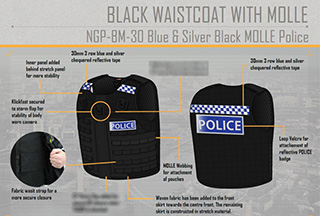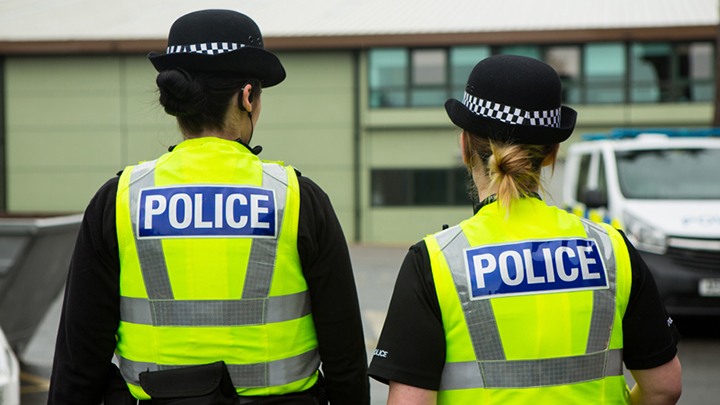Police chiefs obliged by law to provide best protection equipment to officers
13 June 2023
Polfed News
PFEW National Board Member and Health and Safety Lead, Mark Andrews, has said that current health and safety regulations mean that chief constables up and down England and Wales should feel obliged to ensure that their officers have the best available kit, which includes as standard issue the new 3rd generation body armour.
Perhaps the most significant development that the 3rd generation body armour offers is the fact it is now available in gender specific design. For the first time in the provision of body armour, women’s requirements are given equal consideration to that of men.
Under Regulation 4 of Personal Protective Equipment at Work Regulations 1992, ‘every employer shall ensure that suitable personal protective equipment is provided to workers who may be exposed to risk’.
The regulations state that personal protection equipment (PPE) shall not be suitable unless:
(A) It is appropriate for the risk or risks involved, the conditions at the place where exposure to the risk may occur, and the period for which it is worn.
(B) It takes account of ergonomic requirements and the state of health of the person or persons who may wear it, and of the characteristics of the workstation of each such person.
(C) It is capable of fitting the wearer correctly, if necessary, after adjustments within the range for which it is designed.
(D) So far as is practicable, it is effective to prevent or adequately control the risk or risks involved without increasing the overall risk.
(E) It complies with any legal requirement which is applicable to that item of personal protective equipment.
Points B and C of the regulations, it may be argued, provide the legal basis for compulsory provision of gender specific body armour.
Regulations also state that the use of PPE must not increase the overall level of risk, which may be argued means that by not providing female officers with 3rd generation kit, forces are greatly increasing their risk to harm with inadequate kit they have to squeeze into when more suitable alternatives are available.
There may also be a case to be made that because the 3rd generation body armour provides increased protection against sharp object force (knives), also known as increased Supplementary Knife Resistance (SKR), the existing 2nd generation body armour is unsuitable and unable to provide adequate protection in certain circumstances and should be replaced as a matter of priority.
The Police (Health and Safety) Regulations 1999 extended the regulations to the police service, which has to provide suitable PPE (unless there are strong operational reasons not to) and comply with the provisions set out in these Regulations. Police have to comply with these regulations by law unless they have a specific reason not to – it is clearly difficult for them to now justify not having suitable body armour provisions, unless the officer is undercover of course.
The case for investing in the 3rd generation body armour is given even more weight by further points of Regulation 4 which lists factors that determine whether PPE is suitable.
When selecting PPE, the employer should consider and take account of the following factors:
(A) The job itself and the risks for which protection is needed. For example, if there is a risk from falling objects, consider providing suitable industrial safety helmets or hard hats.
(B) The physical effort needed to do the job, how long the PPE has to be worn, and the requirements for visibility and communication.
(C) The environment and surrounding conditions (for example, the weather if working outside, temperature, noise, ventilation etc).
(D) The health of the person wearing the PPE and its ergonomic effects. PPE made of certain materials should not be issued to workers if they are known to cause allergies (for example, latex gloves). Heavy or bulky suits can cause or make worse existing musculoskeletal problems and cause thermal comfort problems.
Point B of the list refers to comfort in PPE and the physical demands of the job when wearing the PPE. This point provides cause for female officers to be provided with a suitable kit when assessing comfort and working in the PPE, both of which are greatly improved by the 3rd generation kit; the issue of comfort and physical demands of the armour are addressed in the weight of the 3rd generation body armour, which is lighter and allows for greater movement than the existing provision.
Ultimately, PPE provision should ensure maximum protection and minimum discomfort to the wearer - uncomfortable armour is unlikely to be worn properly, increasing the risk to injury and threat. Current body armour does not provide maximum protection and minimum discomfort for 35 per cent of the police workforce and on those grounds alone should be upgraded.
Not unreasonably, those using the PPE are considered best placed to understand the demands placed on equipment, and so regulations require that those who do the job be consulted in the selection and specification of equipment. With this in mind, PFEW and police officers were part of the consultation process and so our calls for investment in 3rd gen body armour should not be considered anything other than fair and considered.
It is also important to acknowledge the Equality Act 2010. This Act sets out a number of characteristics that are protected and prevent workers from being discriminated against in relation to these H&S Regulations. These protected characteristics cover age, disability, gender reassignment, marriage and civil partnership, pregnancy and maternity, race, religion or belief, and sex and sexual orientation.
By not providing female specific equipment where it is available, individual Forces are not complying with and are in breach of the Equality Act 2010.
Regulation 6 of Personal Protective Equipment at Work Regulations 1992 - Assessment of personal protective equipment
Before choosing any PPE, which by virtue of Regulation 4 they are required to ensure is provided, an employer… shall ensure that an assessment is made to determine whether the PPE they intend will be provided is suitable.
The assessment required by paragraph (1) shall include:
(A) An assessment of any risk or risks to health or safety which have not been avoided by other means.
(B) The definition of the characteristics which PPE must have in order to be effective against the risks referred to in subparagraph (a) of this paragraph, taking into account any risks which the equipment itself may create.
(C) Comparison of the characteristics of the personal protective equipment available with the characteristics referred to in sub-paragraph (b) of this paragraph.
(D) An assessment as to whether the personal protective equipment is compatible with other personal protective equipment which is in use and which a worker would be required to wear simultaneously.
Given the availability 3rd generation body armour, point C above may be argued to mean that newly available gender specific body armour is again a legal requirement if forces are to comply with Health and Safety regulations.
The regulations further stipulate that:
Every employer… is required by paragraph (1) to ensure that any assessment is made shall ensure that any such assessment is reviewed if:
(A) there is reason to suspect that it is no longer valid; or
(B) there has been a significant change in the matters to which it relates, and where as a result of any such review changes in the assessment are required, that employer or relevant self-employed person shall ensure that they are made.
Given the increase in incidents of knife enable crime across all regions of the country, it is not unreasonable to suggest that previous risk assessments need revisiting and when doing so, be done with the 3rd generation body armour in mind as the standard kit.
It is worth noting that the purpose of the assessment required under regulation 6 is to ensure that the employer, who has to provide PPE, chooses PPE which is correct for the particular risks involved and for the circumstances of its use.
Click here for more information on the 3rd Generation Body Armour.



















